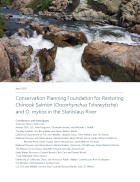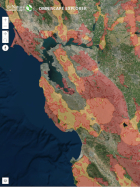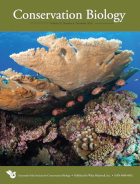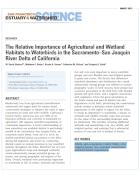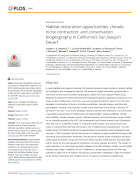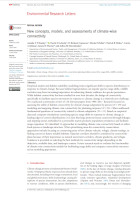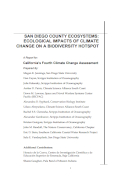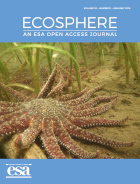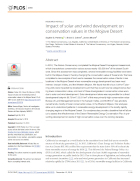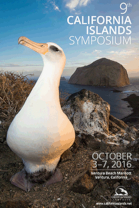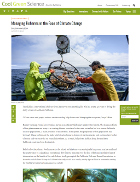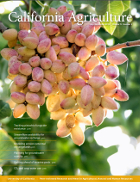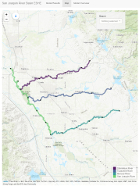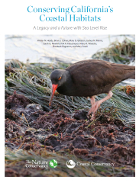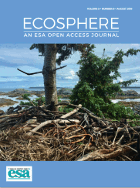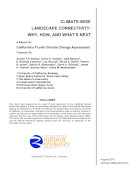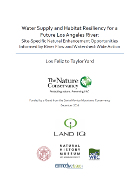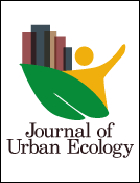Systematic, science-based conservation planning is a hallmark of the Conservancy. For biodiversity to thrive, habitats need to be protected, enhanced, or restored not just in the still wild places on the planet but also where people live and make their livelihoods.
Multi-disciplinary planning can help elucidate where the highest priority places are and what needs to happen there – and inform tradeoffs between conservation and other societal values.
Science in Action
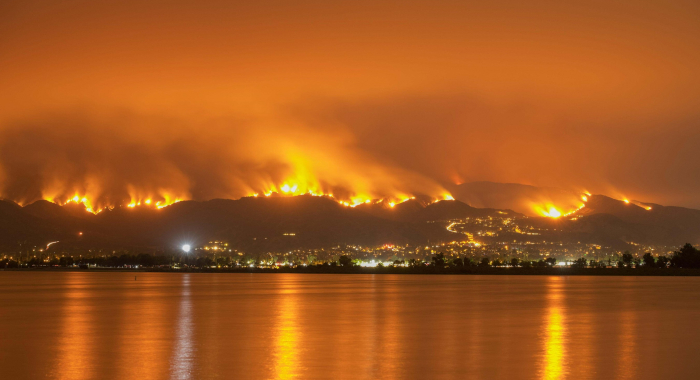
Terrestrial | Planning | Technology | Economics
Wildfire and Communities
How can land protection and restoration help protect communities from wildfire?
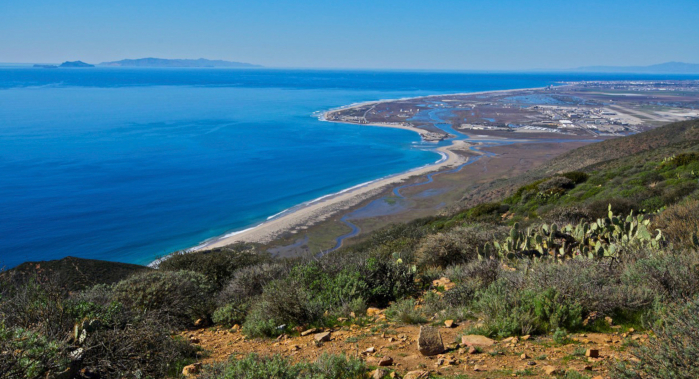
Terrestrial | Marine | Planning
TNC and the U.S. Navy
How can we protect natural resource and coastal military assets from sea level rise?
2019 | Freshwater | Planning | Science | Publications & Reports
Conservation Planning Foundation for Restoring Chinook Salmon (Oncorhynchus tshawytscha) and O. mykiss in the Stanislaus River
Prepared by Anchor QEA, LLC (John Ferguson, Elizabeth Greene, and Michelle L. Ratliff), Contributors and Participants: John Cain, Jon Rosenfield, Alison Weber-Stover, Stephen Louie, John Shelton, Tim Heyne, Brian Ellrott, Sierra Franks, Monica Gutierrez, Rhonda Reed, David Swank, Steve Edmundson, Katie Schmidt, Rachel Johnson, Jeanette Howard, Julie Zimmerman, Chris Carr, Daniel Worth, Rene Henery, Ron Yoshiyama, Joshua Israel, Paul Cadrett, Ramon Martin, and J.D. Wikert
Also view Appendix A: Stanislaus Survival Model and and other report Appendices.2019 | Terrestrial | Planning | Technology | Science | Maps & Webmaps
Planning for connectivity implementation in present-day California and for a changing future: a 3-D web-tour
Carrie Schloss, Dick Cameron, Nathaniel Rindlaub, Connor Shank
This interactive, web-based tour provides an accessible introduction to The Nature Conservancy’s analysis of wildlife movement routes for climate adaptation in California. Viewing these pathways…2019 | Terrestrial | Planning | Technology | Science | Publications & Reports
Circuit-theory applications to connectivity science and conservation
Brett G. Dickson, Christine M. Albano, Ranjan Anantharaman, Paul Beier, Joe Fargione, Tabitha A. Graves, Miranda E. Gray, Kimberly R. Hall, Josh J. Lawler, Paul B. Leonard, Caitlin E. Littlefield, Meredith L. McClure, John Novembre, Carrie A. Schloss, Nathan H. Schumaker, Viral B. Shah, David M. Theobald
The authors explore the impact that Brad McRae’s development of circuit theory and the associated software, Circuitscape, have had, and continue to have, on connectivity science and…2019 | Terrestrial | Planning | Science | Publications & Reports
Making habitat connectivity a reality
Annika T. H. Keeley, Galli Basson, D. Richard Cameron, Nicole E. Heller, Patrick R. Huber, Carrie A. Schloss, James H. Thorne, Adina M. Merenlender
Connectivity conservation must move more rapidly from planning to implementation. We provide an evidence‐based solution composed of key elements for successful on‐the‐ground…2019 | Terrestrial | Planning | Science | Publications & Reports
The Relative Importance of Agricultural and Wetland Habitats to Waterbirds in the Sacramento–San Joaquin River Delta of California
W. David Shuford, Matthew E. Reiter, Kristin A. Sesser, Catherine M. Hickey, Gregory H. Golet
Agricultural intensification has been a major factor in the loss of global biodiversity. Even so, agricultural landscapes provide important habitat for many bird species, particularly in the Central…2019 | Freshwater | Terrestrial | Planning | Science | Publications & Reports
Habitat restoration opportunities, climatic niche contraction, and conservation biogeography in California's San Joaquin Desert
Joseph A. E. Stewart, H. Scott Butterfield, Jonathan Q. Richmond, David J. Germano, Michael F. Westphal, Erin N. Tennant, Barry Sinervo
Due to limited water resources, there is a global trend toward the retirement of farmland, especially in the San Joaquin Valley in California where the Sustainable Groundwater Management Act could…2019 | Terrestrial | Planning | Science | Publications & Reports
New concepts, models, and assessments of climate-wise connectivity
Annika T H Keeley, David D Ackerly, D Richard Cameron, Nicole E Heller, Patrick R Huber, Carrie A Schloss, James H Thorne, Adina M Merenlender
As climate change impacts wildlife and plants, species may need to access new habitats. Various approaches exist to plan to climate-driven habitat connectivity needs. We summarize the literature of…2019 | Freshwater | Terrestrial | Planning | Science | Publications & Reports
San Diego County Ecosystems: Ecological Impacts of Climate Change on a Biodiversity Hotspot
Megan Jennings, Dan Cayan, Julie Kalansky, Amber Pairis, Alexandra Syphard, Rachel Clemesha, Alexander Gershunov, Kristen Guirguis, John Randall, Eric Stein, Sula Vanderplank, Shasta Gaughen
2019 | Marine | Planning | Science | Publications & Reports
An indicator‐based decision framework for the northern California red abalone fishery
William J. Harford, Natalie A. Dowling, Jeremy D. Prince, Frank Hurd, Lyall Bellquist, Jack Likins, Jono R. Wilson
Among abalone species that were once harvested along the California coastline, red abalone (Haliotis rufescens) supports the remaining recreational fishery. To support development of a red abalone…2018 | Terrestrial | Planning | Science | Publications & Reports
Impact of solar and wind development on conservation values in the Mojave Desert
Sophie S. Parker, Brian S. Cohen, James Moore
This paper discusses changes in the conservation value of lands in the California Mojave Desert caused by renewable energy development that occurred between 2009 and 2016. The authors remotely assess…2018 | Freshwater | Terrestrial | Marine | Planning | Science | Publications & Reports
Informing Our Successors: What Botanical Information for Santa Cruz Island will Researchers and Conservation Managers in the Century Ahead Need the Most?
Randall, J.M., K. McEachern, J. Knapp, P. Power, S. Junak, K. Gill, D. Knapp, M. Guilliams
2018 | Marine | Planning | Technology | Science | Blogs
Managing Fisheries in the Face of Climate Change
The author discusses a need for a new paradigm in fisheries management to address the challenges of a changing climate. See related publication by the author and colleagues in Conservation…2018 | Freshwater | Terrestrial | Planning | Economics | Science | Publications & Reports
Groundwater sustainability in the San Joaquin Valley: Multiple benefits if agricultural lands are retired and restored strategically
Rodd Kelsey, Abby Hart, H. Scott Butterfield, Dan Vink
Restoring habitat in retired farmland could reduce water demand and provide ecosystem services for farmers and local communities. In some areas of California, as a result of the Sustainable…2018 | Freshwater | Planning | Science | Maps & Webmaps
Rearing habitat objectives to support salmon in the Central Valley
Travis M. Hinkelman, Myfanwy Johnston, Joseph E. Merz, Julie Zimmerman
To restore degraded stream corridors and develop large-scale, sustainable watershed conservation strategies, it is essential for managers to consider—in order to ultimately…2018 | Freshwater | Terrestrial | Marine | Planning | Science | Publications & Reports
Conserving California's Coastal Habitats: A Legacy and a Future with Sea Level Rise
Walter N. Heady, Brian S. Cohen, Mary G. Gleason, Joshua N. Morris, Sarah G. Newkirk, Kirk R. Klausmeyer, Hilary R. Walecka, Elizabeth Gagneron
Sea level rise presents a new challenge to coastal conservation. The authors quantified and mapped the vulnerability of habitats, imperiled species, and conservation lands to sea level rise throughout…2018 | Freshwater | Terrestrial | Planning | Science | Publications & Reports
Better late than never: a synthesis of strategic land retirement and restoration in California
Chris Lortie, Alex Filazzola, Rodd Kelsey, Abigail Hart, Scott Butterfield
Over the past 100 years, California's Central Valley has undergone a massive transformation from desert to a mosaic of farmland and urban development. This transformation has also meant many…2018 | Freshwater | Terrestrial | Planning | Science | Publications & Reports
Climate-wise Landscape Connectivity: Why, How, and What Next
Annika T.H. Keeley, David D. Ackerly, Galli Basson, D. Richard Cameron, Lee Hannah, Nicole E. Heller, Patrick R. Huber, Patrick R. Roehrdanz, Carrie A. Schloss, James H. Thorne, Samuel Veloz, Adina M. Merenlender
2018 | Terrestrial | Planning | Technology | Science | Blogs
Climate Connectivity Analysis: An Innovation Approach to Identifying Critical Habitat in California
Alex Leumer, Carrie Schloss, Cara Lacey
Plants and animals lack the ability to change their environment. As their current habitat becomes unsuitable due to climate change, they may search out new, more suitable habitat to adapt to changing…2018 | Freshwater | Terrestrial | Planning | Science | Publications & Reports
Water Supply and Habitat Resiliency for a Future Los Angeles River: Site-Specific Natural Enhancement Opportunities Informed by River Flow and Watershed-Wide Action
Brian Cohen, Shona Ganguly, Sophie Parker, John Randall, Jill Sourial, and Lara Weatherly of The Nature Conservancy, Land IQ, Natural History Museum Los Angeles County, WRC Consulting Services Inc., Travis Longcore, University of Southern California, Connective Issue, Inc.
As a basic principle of ecological systems, a watershed’s hydrology determines the flow characteristics of its river system. These flows define what the biological characteristics of that…2018 | Freshwater | Terrestrial | Planning | Science | Publications & Reports
Ecological spillover dynamics of organisms from urban to natural landscapes
Jill E. Spear, Erik K. Grijalva, Julia S. Michaels, Sophie S. Parker
This paper discusses the impact of urban-dwelling plants and animals on regional wildland populations, both within and across species. The authors reviewed the global conservation literature and…
